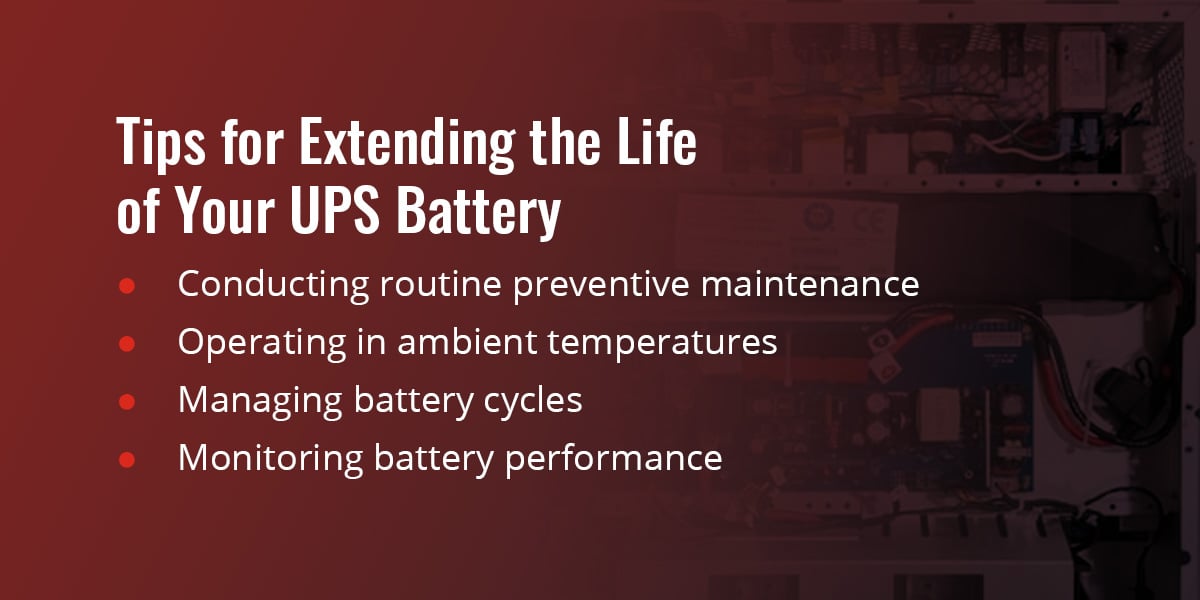RESOURCES
How Long Does a UPS Battery Last: Understanding Run Time and Lifetime of a UPS Battery
Many individuals and businesses rely on uninterruptible power supplies (UPSs) to maintain operations. While these systems are critical, especially in medical applications, they require maintenance and replacement over time. The battery is the heart of a UPS system; any faults or poor performance could result in system failure or failure of the end objective.
Understanding how to maintain a battery’s health and knowing when your UPS battery needs replacing is essential to keeping your system running optimally.
Why Are UPS Batteries Important?
A UPS battery is integral to your uninterruptible power system, storing power, delivering backup power, and protecting electronic equipment. To deliver the needed backup times, the battery must be efficient and reliable and maintain a high level of performance day after day for years to come.

What Are the Standard Battery Types?
Below is a short overview of battery types:
- Lead acid or Sealed lead acid (SLA): Suitable for automobiles, boats, and motorcycles. It is heavy and typically lasts three years.
- Alkaline batteries: Suitable for home electronic devices and some portable electronics; these are not chargeable but will work well for home safety devices like fire and CO2 alarms, security systems, etc.
- Nickel Metal Hydride: suitable for some power tools and hybrid cars.
- Nickel Cadmium batteries are suitable for power tools.
- Lithium-ion batteries: Suitable for consumer electronics like cell phones and laptops
- Lithium-ion, Iron phosphate: Suitable for e-bikes, scooters, and UPS.
Over time, Lithium Ion and Lithium iron phosphate (also called Lithium-ion) replaced most of the battery types.
How Long Do UPS Batteries Last?
Batteries are temporary energy storage banks. They cannot create energy but can store what is input from a charge source. An EV car, for example, needs to be charged with large amounts of energy to move a car with passengers and cargo in it at high speed for hundreds of miles. That is a lot of stored energy, but it is still limited. The batteries no longer have enough ‘juice’ to move the car at a specific mileage. The same thing happens with cell phone batteries. Fortunately, nothing serious happens if they deplete their charge fully.
The time it takes to deplete its charge from full to empty is called the Run time. If a specific battery is specified as 100 Watt-hour, it means that the battery will support 100 watts for One Hour.
If you load it to 50 watts, it will last 2 hours (100/50=2); the charge delivered by the charger will be the same as the charge delivered to the load with a small error due to losses in electronics and wires.
What is the Preferred Way to Charge Batteries?
The charging method depends on the type of battery. Its chemistry should be well understood before a charger is designed. Batteries for consumer devices like electronics and power tools need to be charged fast, generally in less than two hours. The charge method is called Constant current and then Constant voltage (CC/CV). It means that initially, the battery is charged at a steady preset current. The current is reduced as it reaches its full charge, and the off continues at constant voltage (CV).
All lithium batteries use the CC/CV method. However, lead-acid batteries charge differently. The charger is more straightforward and allows for a very high current charge. Lead used to start cars may take 6-8 hours to charge fully. Usually, a good practice is to charge the battery slowly, But modern EV car batteries can be charged slowly or super-fast (as quickly as 20 minutes).
Why Do Batteries “Die”?
Batteries are miniature power plants. They rely on chemicals (electrolytes) and metals (electrodes) to store electrical energy when a charger is connected. When the charger is removed, and the load is connected, the battery discharges stored energy into the load. In other words, the battery cannot charge and discharge simultaneously. In portable electronic devices like cell phones and laptops, this energy steering is managed automatically to maintain the continuous operation of the device.
However, it's common knowledge that if we charge the battery as often as possible, it always seems to run out. In other words, it will discharge after running for a few hours. If Wi-Fi, Bluetooth, and GPA are ongoing in a cell phone, the battery seems to be ‘dying’ pretty fast because those applications use up a lot of backup power. If we don’t connect a charger soon enough, the battery will discharge deep enough to shut down the phone; this has come to be commonly known as “dead”, but it’s not the end of life. Once it is charged sufficiently, it returns to “life.” On a typical day, we charge and discharge them multiple times or about all day.
Regardless of how often we charge in a day, the battery will wear out after a few thousand cycles of charge and discharge because the chemical plant inside just gets contaminated and can’t perform well enough anymore. At that point, no matter how well it is charged, it will not recover. That is the end of life (EOL) of the battery. Also, the battery will lose its ability to back up if stored for too long without charge. In other words, the battery has a limited ‘shelf life’ and calendar life. Not all batteries ‘die’ the same way. Some types will gradually show a reduced performance while others will go well till that lousy day it just collapses. Cell phone and laptop batteries gradually (or gracefully) decline.
Battery-backed UPS systems allow you to keep your systems running until the primary power grid can take over. However, the UPS has limitations — it relies on the energy stored in the battery. However, batteries have a finite running time and life, after which they must be replaced after their useful life. With the help of built-in diagnostics and trained technicians, some preventive maintenance and replacement of the battery is possible. A UPS is an excellent investment for any mission-critical system.
How Does a UPS Battery Backup Work?
The battery is charged while AC mains power is available and at the proper voltage. The UPS system has a built-in charge control that ensures the battery is charged properly while monitoring for safety. When fully charged, the battery can power an artificial AC power source called the Inverter, a critical part of the UPS. The Inverter is generally always ON, but when there is AC mains power, it is powered from AC mains. When the AC mains fail, the battery runs the Inverter. This switchover happens within a fraction of a second. Since the inverter continues to run on battery, the clean AC output from UPS to the load is sustained as if nothing happened. It runs as long as its stored energy is depleted. The battery indicates how much energy is available by a signal that the UPS can read and tell the user by flashing lights or displaying % on a Battery meter.
The primary function of a UPS battery is to store power, converting chemical energy into usable electrical energy. UPS enhances system reliability by cutting off dangerous AC mains fluctuations from the system. So, in a well-managed system, the user’s system always gets clean and stable AC power.
When other effects like lightning and corrupted AC power exist, the UPS absorbs those surges and presents clean AC power to the system. In this sense, UPS does more than just back up.
While electronic circuits in the UPS play a significant part and need to be highly reliable, battery almost always takes priority; apart from being reliable, always in good health, and providing good run times, it must last a long, long time, perhaps a lifetime. Ideally, we should never have to replace them, as we all know how expensive they are.
How Long Do UPS Batteries Last?
Not all batteries are the same. Usually, a battery type suitable for one application is not the best type for another. But almost always, the battery life depends heavily on how many times it is charged and discharged (called Cycle life) and how old it is (called Calendar life). Other minor but significant factors influence battery life.
For the average user, the following life attributes and recommendations will be helpful:
- Cycle life: How often they are charged and discharged.
- Calendar life: How old they are.
- Depth of discharge: a measure of how much the user drains them out each time between charges. Using them till Zero capacity (usually RED zone) means 100% Depth of discharge.
- Operating temperature: how hot the area is and if ventilation keeps the battery cool. Hot areas with poor ventilation will reduce battery life.
- The useful life of the battery (calendar days): This is the total time you can store a battery, inactive or with minimal use, so its capacity remains above 80% of its original capacity.
- The battery's useful life (cycle life): This is the complete number of charge and discharge cycles a battery can undergo before its capacity degrades to below 80% of the original total.
You must also know how long your UPS battery runs before draining out. The run-time of a UPS battery depends on several factors, such as the unit’s size, load, and capacity. Battery capacity is measured in ampere-hours and watt-hours. Use a UPS battery run time estimation calculator for a more accurate estimation.
What Factors Affect a UPS Battery’s Life Span?
Batteries fail faster in conditions outside of the recommended operating parameters. Some of the main factors that influence a battery’s life span include the following:
- Temperature: Batteries work best when stored and used in excellent conditions. There should be good ventilation around the battery to avoid the degradation of chemicals inside. It is common knowledge that a temperature rise of 10 degrees C severely impacts a battery's life.
- Charge and Discharge management: All batteries need some form of controlled charge and discharge, done mainly by electronics, collectively called a Battery Management system (or BMS).
- Life Cycle Management: All batteries need to be monitored for their health, the number of cycles of charge/discharge, temperature, and any signs of internal degradation.
- Maintenance: Checking the health of the battery and timely intervention go a long way to assure reliable performance and safety. Maintenance procedures depend on the type of battery, so following the manufacturer’s recommendations is vital.
Tips for Extending the Life of Your UPS Battery
While UPS batteries are essential to keep your business running smoothly, they represent a significant investment. Taking the following measures can maintain the health of your batteries and increase their longevity:
- Charge it to complete each time
- Do not always let it drain to empty (limit the Depth of discharge).
- Do not expose or store it at temperature extremes (room temperature is best for a battery)
- Please do not drop it
- Do not let it sit unused for a long time
- Do not charge it too fast or with incompatible chargers
- Do not let it run heavy loads like motors and pumps
- Conduct routine maintenance, look for cracks, leaks, etc
- Monitor its backup (run) time closely with a consistent method. A gradual reduction in run time is typical, but drastic change indicates a severe charger problem or an inherent battery problem.
- Consider ‘SMART’ batteries

What Are SMART Batteries and SMART UPS Systems?
As discussed in this document, all battery types need some charge/discharge and general health check. How about using a built-in ‘brain’ to conduct these health checks and help us build a data log?
Since batteries are essentially chemical energy storage plants, it helps to know what’s happening inside its shell, in the electrolyte, or its electrodes. Cell manufacturers can embed a sensor that can be used to read its health. Battery pack manufacturers can use that sensor to report, monitor, and relay that status information sustainably.
In large usage sites, as in hospitals with patient monitoring carts used in thousands, the whole diagnostic system runs off UPS that has been charged overnight and runs all day. Since patient care is a supremely critical mission, such UPS systems on rolling carts must always be in top shape. Innovative UPS systems with intelligent batteries are a massive advantage to the maintenance crew who order, install, and maintain them 24-7-365.
They can use software programs to record the health of their UPS systems and maintain a log that helps them procure new batteries or replace the whole UPS system when the time is right before they abruptly hit the end of life.
When to Replace a UPS Battery
Replacing your batteries and the UPS system in time is necessary. Some of the signs you need to replace your UPS battery include the following:
- Low battery alarm: If you consistently see low battery warnings and flashing lights on the system, your battery could be a good candidate for replacement.
- Extended charging and short discharging times: Replace your UPS battery if it takes longer than usual to charge or discharges quickly.
- Maintenance findings: If your technician finds an issue during regular maintenance, they can provide feedback on replacement options.
- Battery age: If your battery is over five years old, replace it before it performs erratically.
- Unusual behavior: Batteries can display symptoms like flashing pane lights or abnormal displays at the end of their useful life.
- System failure: The battery could need replacing if your UPS system fails to kick in during a power outage.
Are All UPS Systems the Same?
There’s no one-size-fits-all UPS system. UPS systems differ depending on the application and usage requirements. The four central UPS systems have significant differences, including the following:
- Consumer systems: Consumer UPS systems keep electronics and appliances running for individuals and some small businesses.
- Industrial systems: An industrial UPS must support power-heavy devices, handle the required voltage, and back up critical infrastructure. Industrial systems generally require more than a UPS alone for extended power outages. The UPS serves as an intermediary, maintaining operations and backing up data until operators can connect to a secondary power source, such as a generator.
- Medical systems: Due to the critical need for uninterrupted power, a medical-grade UPS is designed with the highest-performance electrical components on the market to meet the IEC 60601 safety standards. Lithium-ion batteries, specifically Lithium Iron Phosphate (LFePO4) batteries, are widely used in medical UPS systems due to their compact, lightweight, and long-life attributes. And, like any other lithium battery, these can be charged very fast, typically within 2 hours.
- Military systems must be rugged enough to operate in harsh environments, including high humidity, excessive vibrations, and electromagnetic interference. Military-grade systems must generally be compact, lightweight, charge fast, and last a very long time without maintenance. For these reasons, lithium batteries are preferred for extended backup applications.
How Does One Select a UPS Vendor?
There are several manufacturers of UPS systems. Depending on the specific application, the supply base narrows as each vendor tries to specialize and bring their expertise and experience to their products. Regardless of the type of UPS, the battery used needs an excellent understanding of chemistry, charge/discharge management, safety, quality, and repeatability.
Since the battery is the most critical element of the UPS system, manufacturers tend to specialize and use the same proven battery for decades, which is critical to building up knowledge and history of its performance in the real world.
Considering all considerations, one should research and narrow down to vendors with a long track record in designing, manufacturing, and deploying UPS systems.
Trust Astrodyne TDI for Dependable UPS Systems
UPS systems — and the batteries that power them — protect countless businesses from the adverse effects of power fluctuations. Knowing how to care for and when to replace your batteries is essential to keeping your system running. Every company has different needs, but all have one thing in common — the need for a UPS system they can rely on.
Astrodyne TDI has decades of experience as an industry leader in providing power to businesses that suit their applications. We carry a wide range of UPS systems, and our experienced team is here to walk you through choosing one best suited to your requirements. Contact us today to learn more about backup power for your business.


